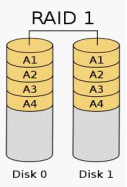Data Recovery -> RAID 1
Storage devices
Types of HDD
Partition Series
Linux
Operating Systems
Windows
RAID 1
Brief Introduction to RAID 1
The RAID 1 disk array level is a mirror disk array. It reflects the data of a disk to the same position of another disk, so ti is called Mirror or Mirroring. It assures the data availability and racoverability to the uttermost. The operation mode of RAID is to copy all data written by users to another disk automatically. Because of its backup of all sstorage data, RAID 1 provides the highest data security in all RAID levels. As the same reason, backup data takes up half of total storage space, which causes the high storage cost and low utilization rate of Mirror disk space. Although Mirror can not improve the storage performance, it has higher data security to store important data such as server and database storage.
As the same reason, backup data takes up half of total storage space, which causes the high storage cost and low utilization rate of Mirror disk space. Although Mirror can not improve the storage performance, it has higher data security to store important data such as server and database storage.
System will read data in source disk. If it reads data successfully, the data in backup disk will be left alone. If reading source disk data fails, system will automatically read data in backup disk. And this guarantees the continuous operation of users. Of course, the damaged disk must be replaced timely and Mirror should be rebuilt through backup data to avoid irretrievable data loss when backup disk is damaged.
Advantages and Disadvantages of RAID 1
RAID 1 is an array composed of RAID disk arrays in which contain 2 disks. And its capacity is the same as one hard disk for the other one is only data mirror. RAID disk array is the most reliable one for it has a complete data backup. Its performance is not as good as that of RAID 0 disk array, but its data-read speed is higher than that of single disk for data-read is executed in the quicker one. The write-speed of RAID 1 disk array is usually lower for the data has to be written into 2 disks and compared. RAID disk array is in support of Hot Swap generally, which means disk remove or replacement can process when system runs, and there is no need to log out.
RAID 1 disk array is very safe but it is also an expensive solution for RAID disk array for 2 disks only provide capacity of single disk. RAID disk array is mainly used when high data security and rapid data recovery are needed.
The RAID 1 disk array level is a mirror disk array. It reflects the data of a disk to the same position of another disk, so ti is called Mirror or Mirroring. It assures the data availability and racoverability to the uttermost. The operation mode of RAID is to copy all data written by users to another disk automatically. Because of its backup of all sstorage data, RAID 1 provides the highest data security in all RAID levels.
 As the same reason, backup data takes up half of total storage space, which causes the high storage cost and low utilization rate of Mirror disk space. Although Mirror can not improve the storage performance, it has higher data security to store important data such as server and database storage.
As the same reason, backup data takes up half of total storage space, which causes the high storage cost and low utilization rate of Mirror disk space. Although Mirror can not improve the storage performance, it has higher data security to store important data such as server and database storage.System will read data in source disk. If it reads data successfully, the data in backup disk will be left alone. If reading source disk data fails, system will automatically read data in backup disk. And this guarantees the continuous operation of users. Of course, the damaged disk must be replaced timely and Mirror should be rebuilt through backup data to avoid irretrievable data loss when backup disk is damaged.
Advantages and Disadvantages of RAID 1
RAID 1 is an array composed of RAID disk arrays in which contain 2 disks. And its capacity is the same as one hard disk for the other one is only data mirror. RAID disk array is the most reliable one for it has a complete data backup. Its performance is not as good as that of RAID 0 disk array, but its data-read speed is higher than that of single disk for data-read is executed in the quicker one. The write-speed of RAID 1 disk array is usually lower for the data has to be written into 2 disks and compared. RAID disk array is in support of Hot Swap generally, which means disk remove or replacement can process when system runs, and there is no need to log out.
RAID 1 disk array is very safe but it is also an expensive solution for RAID disk array for 2 disks only provide capacity of single disk. RAID disk array is mainly used when high data security and rapid data recovery are needed.